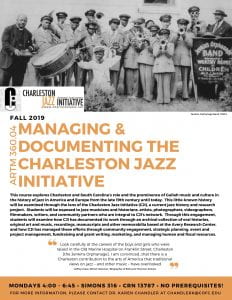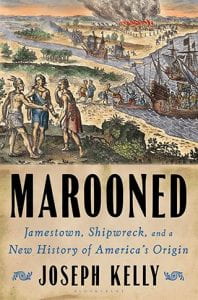This post is by Melissa R. Klapper, Professor of History and Director of Women’s & Gender Studies, Rowan University.
During my visit to Charleston last March as research fellow at the Pearlstine/Lipov Center for Southern Jewish Culture, I made a sort of pilgrimage to 5 Pitt Street, the house where sisters Anita, Carrie, and Mabel Pollitzer grew up.  I was delighted not only to see a historical marker on the site, but also to see that Carrie and Mabel got their due as well as their more famous (outside Charleston, at least) younger sister Anita.
I was delighted not only to see a historical marker on the site, but also to see that Carrie and Mabel got their due as well as their more famous (outside Charleston, at least) younger sister Anita. 
 Anita (1894–1975), who left Charleston for college after graduating from Memminger High School and never really returned to the city to live, gained national and even international renown for her work with the National Woman’s Party, the more militant wing of the suffrage movement. After the ratification of the Nineteenth Amendment in 1920, she continued to work on feminist issues, most notably as a longtime advocate for the Equal Rights Amendment, which was first brought before Congress in 1923. Her sisters Mabel and Carrie also ardently worked for women’s enfranchisement and were charter members of the Charleston Equal Suffrage League. Carrie (1881–1974) served as the assistant principal of Memminger, directed the South Carolina Kindergarten Training School, and became active in the Charleston City Federation of Women’s Clubs. Mabel (1885–1979) graduated from Teachers College at Columbia University in New York and then returned home to teach at Memminger. She was president of the Charleston County Teachers’ Association and helped establish the Charleston County Library. Both Carrie and Mabel lived to a ripe old age and became beloved figures in the city. But that didn’t mean they never left Charleston.
Anita (1894–1975), who left Charleston for college after graduating from Memminger High School and never really returned to the city to live, gained national and even international renown for her work with the National Woman’s Party, the more militant wing of the suffrage movement. After the ratification of the Nineteenth Amendment in 1920, she continued to work on feminist issues, most notably as a longtime advocate for the Equal Rights Amendment, which was first brought before Congress in 1923. Her sisters Mabel and Carrie also ardently worked for women’s enfranchisement and were charter members of the Charleston Equal Suffrage League. Carrie (1881–1974) served as the assistant principal of Memminger, directed the South Carolina Kindergarten Training School, and became active in the Charleston City Federation of Women’s Clubs. Mabel (1885–1979) graduated from Teachers College at Columbia University in New York and then returned home to teach at Memminger. She was president of the Charleston County Teachers’ Association and helped establish the Charleston County Library. Both Carrie and Mabel lived to a ripe old age and became beloved figures in the city. But that didn’t mean they never left Charleston.
I came to Addlestone Library, home of the College of Charleston’s Special Collections and the South Carolina Historical Society’s archives, to conduct research for my current book project on American Jewish women who traveled abroad between the end of the Civil War and the beginning of World War II. These decades saw foreign travel become more accessible to a growing number of Americans thanks to the development of less expensive tourist-class travel and accommodation and the growing popularity of the idea of vacations. All three Pollitzer sisters traveled with some frequency. And in 1926 Carrie set out on what turned into an epic journey of nearly two years abroad, keeping a travel journal all the while (Anita Pollitzer Family Papers, SCHS 1210.00, Box 24/29/1). That travel journal is the very stuff of history, and in its pages Carrie’s comments on her adventures shed valuable light on the way that American, gender, and Jewish identity interplayed in all American Jewish women’s travels abroad.
The travel journal covers a lot of ground, but there are three elements I will emphasize here. The first is Jewish identity. The Pollitzer family was involved with KKBE, but none of the sisters were traditionally observant and Jewishness rarely shaped their life choices. Still, while abroad, like many other American Jewish women, they found themselves attending synagogue services, marking Jewish holidays in their diaries, socializing with other Jews, and visiting Jewish homelands, memorials, and cemeteries. Carrie ate at a kosher lunchroom in Paris (August 2, 1926), remarked on the Arch of Titus in Rome, which was erected to commemorate the destruction of Jerusalem (December 26, 1926), and visited her maternal family’s synagogue in Vienna. Of this last experience she wrote, “This morning I went to services in the old synagogue where my grandparents worshipped. I feel it a great privilege to be able to do this. The synagogue is small but very fine. The chanting was beautiful” (June 18, 1927).
The second noteworthy element of the journal is Carrie’s reaction to the standard sightseeing she did. She benefited from the new tourist industry that had developed over the previous few decades, which sprang up to serve adventurous but not necessarily wealthy travelers, a mass of people who depended on affordable guidebooks, maps, and markers to ease their journeys and tell them where to go and what to do. Like so many others, Carrie dutifully admired the art at the Louvre (July 28, 1926) and went to see “The Last Supper” in Milan (October 21, 1926). She was not always so impressed by the standard sights, however. After touring St. Peter’s Basilica in Rome, she drily noted that “The most flattering comment I can truthfully make: It is big, its pictures are big, its sculpture is big. The whole thing is big and glitters with gold” (December 12, 1926).

The last element of the journal worthy of comment here is the displacement that accompanied even the most exciting extended trips abroad. While Anita joined her for segments of her trip, Carrie traveled alone for much of the time. Though she interacted with all kinds of people, she began to feel sad and tired of being so much on her own. Marking Thanksgiving in her journal in 1927, she wrote disconsolately, “I feel so lonely. I wish I were in Bft. [Beaufort] with bright faces around me” (November 25, 1927). Soon afterward she decided to go home to Charleston.
As these (hopefully tantalizing) references to Carrie Pollitzer’s travel journal make clear, American Jewish women’s travel experiences reflected, both literally and metaphorically, the opening up of the world to women. Looking at Jewish women in particular allows for analysis of the ways in which travel disrupted and complicated identity for a group whose religious and cultural traditions emphasized conventionally gendered notions of female domesticity, even though such notions were often honored in the breach by economically active and activist American Jewish women of all class backgrounds. Southern Jewish women like the Pollitzer sisters were just as likely to take advantage of new opportunities for travel as any others, bringing their experiences home with them to enrich their families and communities.



































